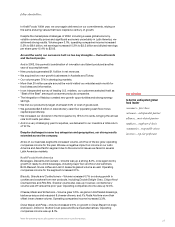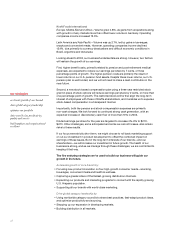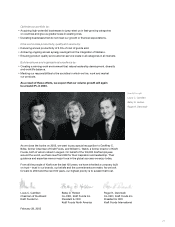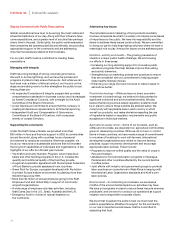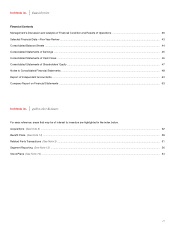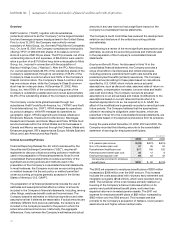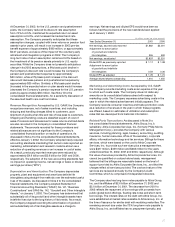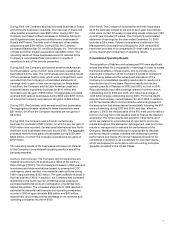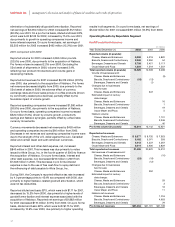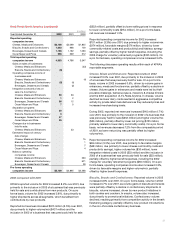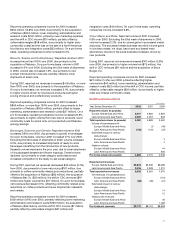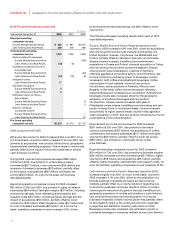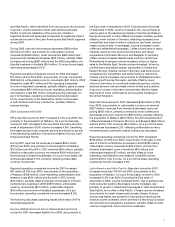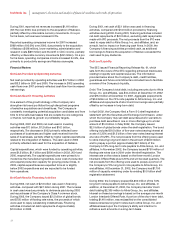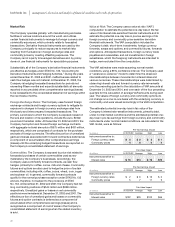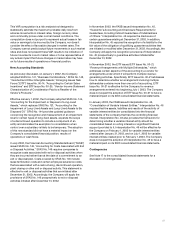Kraft 2002 Annual Report Download - page 35
Download and view the complete annual report
Please find page 35 of the 2002 Kraft annual report below. You can navigate through the pages in the report by either clicking on the pages listed below, or by using the keyword search tool below to find specific information within the annual report.
2002 compared with 2001
Reported volume for 2002 increased 1,157 million pounds (6.7%)
over 2001, due primarily to the inclusion in 2002 of a business
previously considered held for sale, new product introductions,
geographic expansion and acquisitions. Pro forma volume
increased 3.1% over 2001, due primarily to new product
introductions, geographic expansion and acquisitions.
Reported net revenues for 2002 increased $489 million (1.7%)
over 2001, due primarily to the inclusion in 2002 of a business
previously considered held for sale, higher volume/mix and the
impact of acquisitions, partially offset by the adverse effect of
currency exchange rates and lower sales prices on cheese and
coffee products (driven by commodity-related declines). Pro
forma net revenues increased $269 million (0.9%) over 2001,
due primarily to higher volume/mix ($401 million) and the impact
of acquisitions ($191 million), partially offset by the adverse
effect of currency exchange rates ($291 million) and lower sales
prices on cheese and coffee products (driven by commodity-
related declines).
The Company’s management reviews operating companies
income to evaluate segment performance and allocate resources.
Operating companies income excludes general corporate
expenses and amortization of intangibles. Reported operating
companies income was affected by the following unusual items
during 2002 and 2001:
• Integration Costs and a Loss on Sale of a Food Factory: During
2002, the Company recorded pre-tax integration related charges
of $115 million to consolidate production lines, close facilities
and for other consolidation programs. In addition, during 2002,
the Company reversed $4 million related to the loss on sale of a
North American food factory. During 2001, the Company incurred
pre-tax integration costs of $53 million for site reconfigurations
and other consolidation programs in the United States. In
addition, the Company recorded a pre-tax charge of $29 million
to close a North American food factory. These items were
included in the operating companies income of the following
segments:
(in millions)
2002 2001
Cheese, Meals and Enhancers $30 $63
Biscuits, Snacks and Confectionery 12
Beverages, Desserts and Cereals 56 12
Oscar Mayer and Pizza 75
Latin America and Asia Pacific 17
$111 $82
• Separation Programs: During 2002, approximately 700 salaried
employees elected to retire or terminate employment under
voluntary retirement programs. As a result, the Company
recorded a pre-tax charge in 2002 of $142 million related to these
programs. This charge was included in the operating companies
income of the following segments: Cheese, Meals and Enhancers,
$60 million; Biscuits, Snacks and Confectionery, $3 million;
Beverages, Desserts and Cereals, $47 million; Oscar Mayer and
Pizza, $25 million; Europe, Middle East and Africa, $5 million; and
Latin America and Asia Pacific, $2 million.
• Businesses Held for Sale: During 2001, certain small Nabisco
businesses were reclassified to businesses held for sale,
including their estimated results of operations through anticipated
sale dates. These businesses have subsequently been sold with
the exception of one business that had been held for sale since
the acquisition of Nabisco. This business, which is no longer held
for sale, has been included in 2002 reported operating results and
has been included as an adjustment to arrive at pro forma results
for 2001.
Reported operating companies income increased $248 million
(4.1%) over 2001. On a pro forma basis, operating companies
income increased $333 million (5.5%), driven primarily by volume
growth and favorable margins.
In addition, reported net earnings were also affected by the
following during 2002:
• Amortization of Intangibles: On January 1, 2002, the Company
adopted SFAS No. 141 and SFAS No. 142. As a result, the
Company stopped recording the amortization of goodwill and
indefinite life intangible assets as a charge to earnings. Reported
net earnings and diluted EPS would have been approximately
$2.8 billion and $1.76, respectively, for the year ended December
31, 2001, and $2.5 billion and $1.74, respectively, for the year
ended December 31, 2000, had the provisions of the new
standards been applied in those periods.
Currency movements have decreased net revenues by
$291 million and operating companies income by $4 million
from 2001. Decreases in net revenues and operating companies
income are due primarily to the strength of the U.S. dollar
against certain Latin American currencies, partially offset by the
weakness of the U.S. dollar against the euro and other currencies.
Reported interest and other debt expense, net, decreased
$590 million in 2002. This decrease was due primarily to lower
debt levels after the repayment of Nabisco acquisition borrowings
with the proceeds from the Company’s IPO, as well as the
Company’s refinancing of notes payable to Altria Group, Inc. and
lower short-term interest rates. On a pro forma basis, interest and
other debt expense, net, decreased $288 million in 2002 from
$1,135 million in 2001. This decrease in pro forma interest expense
is due to the use of free cash flow to repay debt, the refinancing
of notes payable to Altria Group, Inc. and lower short-term
interest rates.
During 2002, the Company’s reported effective tax rate
decreased by 9.9 percentage points to 35.5% as compared
with 2001, due primarily to the adoption of SFAS No. 141 and
SFAS No. 142, under which the Company is no longer required
to amortize goodwill and indefinite life intangible assets as a
charge to earnings.
Reported diluted and basic EPS, which were both $1.96 for
2002, increased by 67.5% over 2001, due primarily to growth in
operating companies income, lower interest expense and the
31


